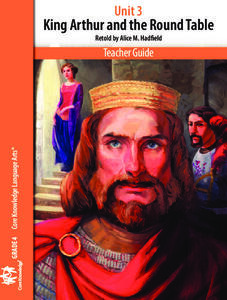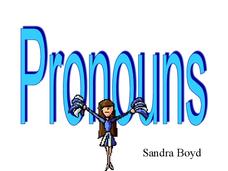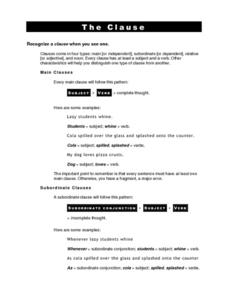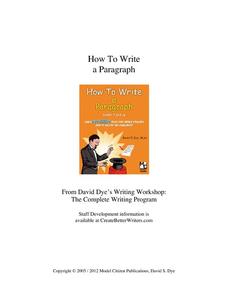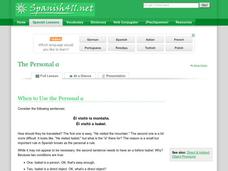Jackson College
Paraphrasing: Borrowing Language and Ideas
How to paraphrase, when to paraphrase, and the difference between paraphrasing and quoting is the focus of a 23-slide, color-coded presentation that not only instructs viewers but also asks them to demonstrate their understanding of the...
Core Knowledge Foundation
Unit 3: King Arthur and the Round Table
Over four weeks, fourth graders study King Arthur and the Round Table, retold by Alice M. Hadfield. Fifteen lessons take pupils through each chapter, complete word work, and the writing process to draft paragraphs, sentences, dialogue,...
Chomp Chomp
The Subordinate Clause
After Amy sneezed all over the tuna salad. So what happened? That is the question readers ask when faced with a subordinate clause unattached to a main clause. And this information sheet shows writers how to combine subordinate clauses...
Lesson Plansos
Guided Reading Activities with Pizzazz
Get the most out of your guided reading lessons with this collection of literacy materials. Offering a system for using color-coded tags to mark pages while reading books, as well as an assortment of comprehension and grammar...
EngageNY
The Painted Essay for Opinion Writing: Developing a Conclusion and Adding Linking Words
Let's get colorful! Scholars use the Painted Essay technique to analyze and color code the conclusion of a model essay. Working in small groups, pupils then write a conclusion paragraph for their draft editorials about offshore...
Curated OER
Spanish Parts of Speech (Part 1)
Check out this overview of the parts of speech that includes English and Spanish examples. Each part of speech is highlighted in a different color for clarity. There is information on each part of speech here, and you or your pupils can...
TV411
Dependent and Independent Clauses Join Forces
Young grammarians are often confused by clauses, especially the difference between dependent and independent clauses. Clarify the confusion with a color-coded learning exercise that clearly defines and illustrates the differences and...
TV411
Learn the Steps to Clear Essay Writing!
Introduce your young writers to the five-paragraph expository essay format with a four-page worksheet that uses color codes to model for writers how to craft the essay. Although designed to prepare writers for the GED, the approach can...
Curated OER
Conjugating Verbs in Spanish
It's time to conjugate! If your class doesn't really know what that means, use the materials provided here to build understanding. The resource covers verbs, infinitives, the different Spanish verb endings, conjugation in the present...
Curated OER
Pronouns
Subject, object personal. Possessive, reflexive, indefinite. Everything you want to know about pronouns and their antecedents is contained in a colorful 32-slide presentation.
EngageNY
Grade 9 ELA Module 3, Unit 3, Lesson 7
As the unit on research writing draws to a close, class members continue to revise and edit their papers, this time focusing on grammar, spelling, and punctuation (colon and semicolon).
Robin L. Simmons
The Clause
This handy information sheet shows young grammarians how to distinguish among main, subordinate, relative, and noun clauses.
Model Citizen Publications
How To Write a Paragraph
Instructing learners on how to craft a good paragraph, a skill required of all writers, is the focus of a 23-page packet that includes directions, graphic organizers, exercises, and worksheets for guided practice.
Curated OER
Spanish Reflexive Verbs
Why is it that in English you shave, and in Spanish you shave yourself? Spanish uses reflexive verbs. Your pupils can master reflexive verbs with the explanation provided here. Conjugation of this type of verb is described with...
Curated OER
The Passive Voice in Spanish
The passive voice was mastered by Spanish learners. Your class members can find out all about how to create the passive voice in Spanish using ser, past participles, por, and the impersonal se. Examples are provided for each situation.
TV411
Understanding Hard Words
Two strategies for decoding unfamiliar words are featured on a worksheet that illustrates how to use the parts of words (prefix, root, and suffix) and context to determine meaning. Examples are included as is a guided practice exercise.
Curated OER
The Personal a
Introduce your Spanish class to the personal a, used when the direct object is a person or personified thing. You can show the provided presentation first and direct them to the other two tabs on this webpage for reference and additional...
C-SPAN
14th Amendment Equal Protection Clause
Two Supreme Court cases, Plessy v. Ferguson and Brown v. Board of Education take center stage in a lesson about the Equal Protection Clause of the 14th Amendment. Class members research both cases to compare and contrast the rulings.

